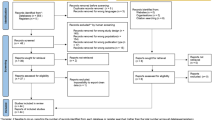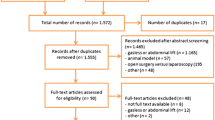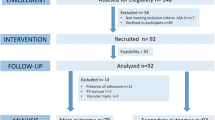Abstract
Background: The pneumoperitoneum is the crucial element in laparoscopic surgery. Different clinical problems are associated with this procedure, which has led to various modifications of the technique. The aim of this guideline is to define the scientifically proven standards of the pneumoperitoneum. Methods: Based on systematic literature searches (Medline, Embase, and Cochrane), an expert panel consensually formulated clinical recommendations, which were graded according to the strength of available literature evidence. Recommendations: Preoperatively, all patients should be assessed for the presence of cardiac, pulmonary, hepatic, renal, or vascular comorbidity. Presupposing appropriate perioperative measures and surgical technique, there is no reason to contraindicate pneumoperitoneum in patients with peritonitis or intraabdominal malignancy. During laparoscopy, monitoring of end tidal CO2 concentration is mandatory. The available data on closed- (Veress needle) and open-access techniques do not allow us to principally favor the use of either technique. Using 2 to 5-mm instead of 5 to 10-mm trocars improves cosmetic result and postoperative pain marginally. It is recommended to use the lowest intraabdominal pressure allowing adequate exposure of the operative field, rather than using a routine pressure. In patients with limited cardiac, pulmonary, or renal function, abdominal wall lifting combined with low-pressure pneumoperitoneum might be an alternative. Abdominal wall lifting devices have no clinically relevant advantages compared to low-pressure (5–7 mmHg) pneumoperitoneum. In patients with cardiopulmonary diseases, intra- and postoperative arterial blood gas monitoring is recommended. The clinical benefits of warmed, humidified insufflation gas are minor and contradictory. Intraoperative sequential intermittent pneumatic compression of the lower extremities is recommended for all prolonged laparoscopic procedures. For the prevention of postoperative pain a wide range of treatment options exists. Although all these options seem to reduce pain, the data currently do not justify a general recommendation.
Similar content being viewed by others
Author information
Authors and Affiliations
Rights and permissions
About this article
Cite this article
Neudecker, J., Sauerland, S., Neugebauer, E. et al. The European Association for Endoscopic Surgery clinical practice guideline on the pneumoperitoneum for laparoscopic surgery. Surg Endosc 16, 1121–1143 (2002). https://doi.org/10.1007/s00464-001-9166-7
Received:
Accepted:
Published:
Issue Date:
DOI: https://doi.org/10.1007/s00464-001-9166-7




